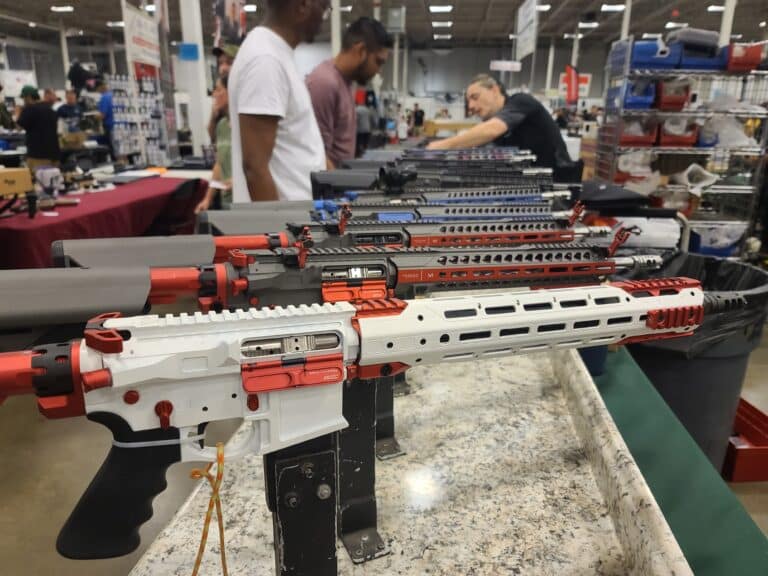Democratic lawmakers are set to try once more to get a new federal gun ban on President Joe Biden’s desk.
Senators Martin Heinrich (D., N.M.) and Angus King (I., Maine), who caucuses with the Democrats, introduced a new bill on Thursday aimed at so-called assault weapons and large-capacity magazines. The proposal would prohibit the sale and manufacture of semi-automatic rifles with detachable magazines, as well as some handguns and devices that “materially increase” a gun’s rate of fire. It would also ban the sale and manufacture of any detachable magazine capable of holding more than ten rounds.
“For years, I have said that rather than using the appearance of these guns to restrict them, we should instead focus on how these weapons actually work and the features that make them especially dangerous,” Senator King said in a press release. “The Gas-Operated Semiautomatic Firearm Exclusion (GOSAFE) Act addresses the lethal capacity weapons like the one used in Lewiston and most of the deadliest mass shootings across the country.”
Senators Mark Kelly (D., Ariz.) and Michael Bennet (D., Colo) joined on to co-sponsor the bill as well.
The bill represents a novel attempt to advance a familiar political football for gun-control advocates. While most previous state and federal assault weapon ban bills have defined restricted weapons based on their semi-automatic function and a limited number of ergonomic or cosmetic accessories, such as pistol grips or adjustable stocks, the GOSAFE Act takes a slightly different approach. It purports to target semi-automatic firearms that can accept a detachable magazine and use a “gas-operated” system to function–though the bill’s text bans guns that use other operating systems too.
The bill received support from the country’s largest gun-control organizations out of the gate, and King noted that three of the four co-sponsors had not sponsored an assault weapon ban before. That could signal the effort is a new legislative strategy for banning certain guns and ammunition magazines gun-control advocates have long wanted to see outlawed.
At the same time, the bill’s chances of making it into law before the 2024 election are slim to none. Democrats currently lack filibuster-proof majorities in the Senate, and it is not clear that key Democratic Senators like Jon Tester (MT) and Joe Manchin (WV) support the bill. Furthermore, Republicans maintain control of the House of Representatives, making it unlikely that the bill would see a vote. Meanwhile, the Supreme Court’s 2022 New York State Rifle & Pistol Association v. Bruen decision casts doubt on the plan’s constitutionality. That decision—and the text, history, and tradition-based legal test it established—could make it difficult for the GOSAFE Act to survive scrutiny.
The bill is similar in many ways to traditional “assault weapon” bans. In some ways, it is more restrictive than previous bans. It defines the gas-operated semi-automatic firearms that would be prohibited under the bill as “any firearm that harnesses or traps a portion of the high-pressure gas from a fired cartridge to cycle the action.” That definition essentially covers how nearly all semi-automatic firearms operate. It then also extends that definition to operating systems that are generally not considered “gas operated” by gun enthusiasts, such as blowback or recoil-operated systems.
However, the GOSAFE Act also features carveouts not included in previous “assault weapon” bans. The bill exempts “recoil-operated” handguns from its proposed regulations. It features a carveout for semi-automatic shotguns of all kinds as well. Additionally, the law’s authors exempt any rifle or shotgun with a permanently fixed magazine capable of holding ten rounds or less and any handgun with a permanently fixed magazine of 15 rounds or less.
Owners of newly-banned firearms and magazines would be allowed to maintain possession of them under the bill, but they would be prohibited from future purchases. They would only be allowed to transfer their newly prohibited firearms and accessories to immediate family members or the government in an optional buy-back program established by the bill.
Senator Heinrich described the bill as a way to balance the rights of law-abiding gun owners with the need to ban “inherently dangerous and unusually lethal” guns.
“Like many New Mexicans, I am a gun owner. I firmly believe we must uphold the laws that protect safe and responsible gun ownership,” he said. “This bill achieves that, while taking steps to get those firearms that are inherently dangerous and unusually lethal, designed for maximum harm, out of the hands of those who pose a threat to themselves or others.”
The National Shooting Sports Foundation, the gun industry’s trade group, countered that the bill is a “knee-jerk reaction” to the mass shooting in Lewiston, Maine. Larry Keane, the group’s senior vice president, argued that Congress’ attention should be focused on how that shooter was able to access his firearms despite repeatedly making violent threats and being ordered to a mental facility instead of banning certain guns and accessories.
“Depriving law-abiding citizens of their Constitutional rights for the criminal acts of a depraved individual doesn’t make our communities safer,” he said in a statement.
Senator King said the bill’s text was filed on Thursday, but it has yet to be assigned a bill number or show up in the congressional legislative tracker.






